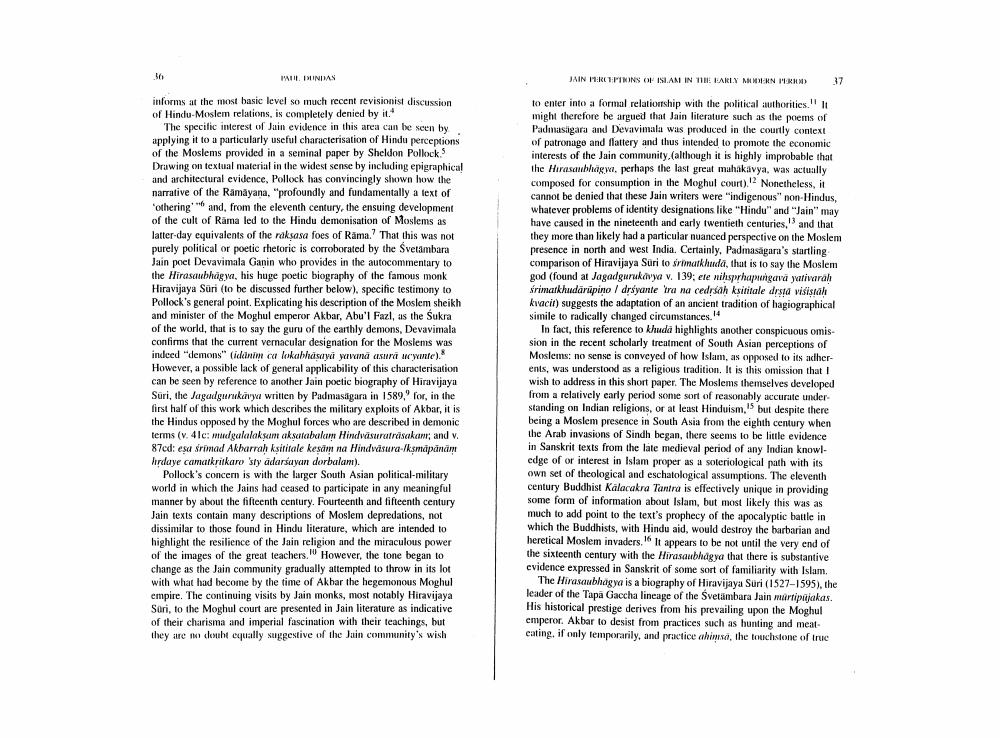________________
MATUNDAS
JAIN 1:11P1INS OF ISLAND IN THE EARLY M
AN MED
37
informs at the most basic level so much recent revisionist discussion of Hindu-Moslem relations, is completely denied by it."
The specific interest of Juin evidence in this area can be seen by applying it to a particularly useful characterisation of Hindu perceptions of the Moslems provided in a seminal paper by Sheldon Pollock Drawing on textual material in the widest sense by including epigraphical and architectural evidence, Pollock has convincingly shown how the narrative of the Ramayana, "profoundly and fundamentally a text of 'othering and, from the eleventh century, the ensuing development of the cult of Rama led to the Hindu demonisation of Moslems as latter-day equivalents of the raksasa foes of Rāma.? That this was not purely political or poetic rhetoric is corroborated by the Svetambara Jain poet Devavimala Ganin who provides in the autocommentary to the Hirasaubhagya, his huge poetic biography of the famous monk Hiravijaya Suri (to be discussed further below), specific testimony to Pollock's general point. Explicating his description of the Moslem sheikh and minister of the Moghul emperor Akbar, Abu'l Fazl, as the Sukra of the world, that is to say the guru of the earthly demons, Devavimala confirms that the current vernacular designation for the Moslems was indeed demons" icinim cu lokabhasay yerind curvi srcante). However, a possible lack of general applicability of this characterisation can be seen by reference to another Jain poetic biography of Hiravijaya Suri, the Jagadgurukary written by Padmasagara in 1589,' for, in the first half of this work which describes the military exploits of Akbar, it is the Hindus opposed by the Moghul forces who are described in demonic terms (v. 41c: mudgulalaksumaksutabulam Hindasuratrusakanr; and v. 87cd: esa srinad Akbarrah ksititale kesäm na Hind wasura-/ksmapanan hurdaye camakrikaro sty adarsayan dorbalam).
Pollock's concern is with the larger South Asian political-military world in which the Jains had ceased to participate in any meaningful manner by about the fifteenth century. Fourteenth and fifteenth century Jain texts contain many descriptions of Moslem depredations, not dissimilar to those found in Hindu literature, which are intended to highlight the resilience of the Jain religion and the miraculous power of the images of the great teachers. However, the tone began to change as the Jain community gradually attempted to throw in its lot with what had become by the time of Akbar the hegemonous Moghul empire. The continuing visits by Jain monks, most notably Hiravijaya Sari, to the Moghul court are presented in Jain literature as indicative of their charisma and imperial fascination with their teachings, but they are debe equally suggestive of the Jain community's wish
to enter into a formal relationship with the political authorities. It might therefore he argued that Jain literature such as the poems of Padmasigara and Devavimala was produced in the courtly context of patronage and flattery and thus intended to promote the economic interests of the Jain community. (although it is highly improbable that the Hirasaubhagwi. perhaps the last great muhakavya, was actually composed for consumption in the Moghul court). Nonetheless, it cannot be denied that these Jain writers were "indigenous" non-Hindus, whatever problems of identity designations like "Hindu" and "Jain" may have caused in the nineteenth and early twentieth centuries, and that they more than likely had a particular nuanced perspective on the Moslem presence in north and west India. Certainly, Padmasagan's startling comparison of Hiravijaya Suri to srimatkhuda, that is to say the Moslem god (found at Jagadgurukavya v. 139, ele nisperhapugava ylivarah srimarkhudarūpino / drsyunte 'tra na cedrah ksititale drsia visistal kvacit) suggests the adaptation of an ancient tradition of hagiographical simile to radically changed circumstances.
In fact, this reference to khuda highlights another conspicuous omission in the recent scholarly treatment of South Asian perceptions of Moslems: no sense is conveyed of how Islam, as opposed to its acherents, was understood as a religious tradition. It is this omission that I wish to address in this short paper. The Moslems themselves developed from a relatively early period some sort of reasonably accurate understanding on Indian religions, or at least Hinduism, but despite there being a Moslem presence in South Asia from the eighth century when the Arab invasions of Sindh began, there seems to be little evidence in Sanskrit texts from the late medieval period of any Indian knowledge of or interest in Islam proper as a soteriological path with its own set of theological and eschatological assumptions. The eleventh century Buddhist Kalacakra Tantra is effectively unique in providing some form of information about Islam, but most likely this was as much to add point to the text's prophecy of the apocalyptic battle in which the Buddhists, with Hindu aid, would destroy the barbarian and heretical Moslem invaders. It appears to be not until the very end of the sixteenth century with the Hirasaubhagya that there is substantive evidence expressed in Sanskrit of some sort of familiarity with Islam.
The Hirasaubhagya is a biography of Hiravijaya Suri (1527-1595), the leader of the Tapa Gaccha lineage of the Svetambara Jain martiljakas. His historical prestige derives from his prevailing upon the Moghul emperor. Akbar to desist from practices such as hunting and meat cating, if only temporarily, and practice ahimisa, the touchstone of true




